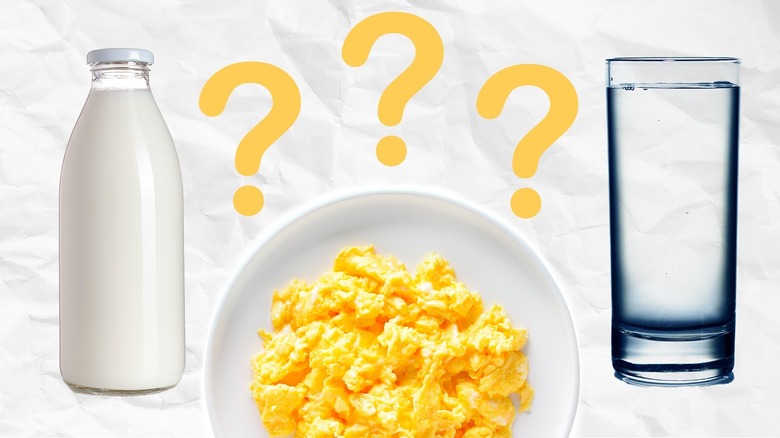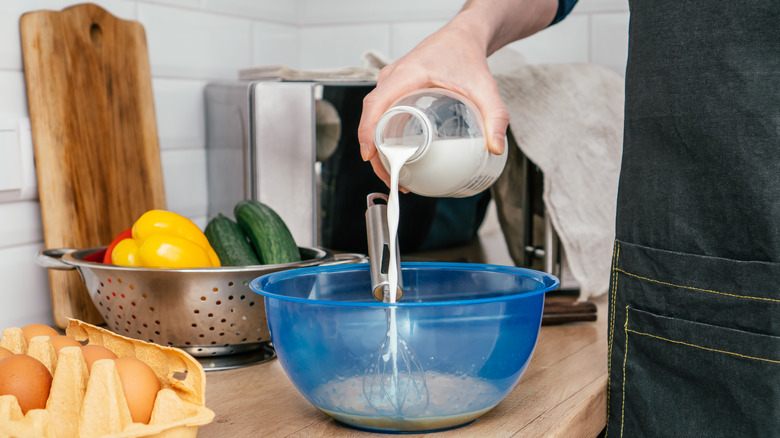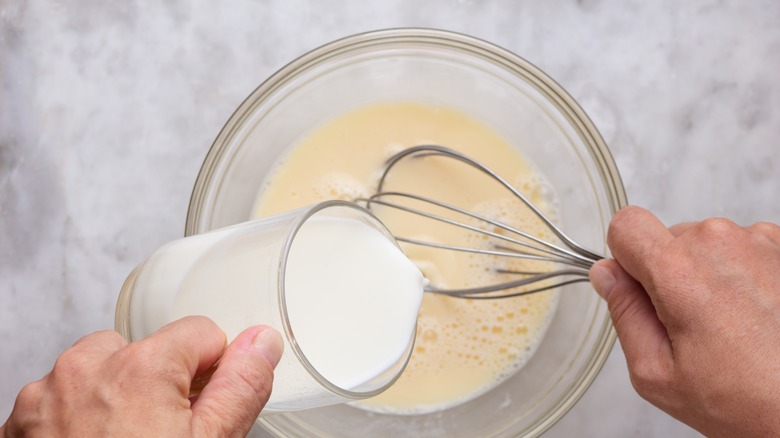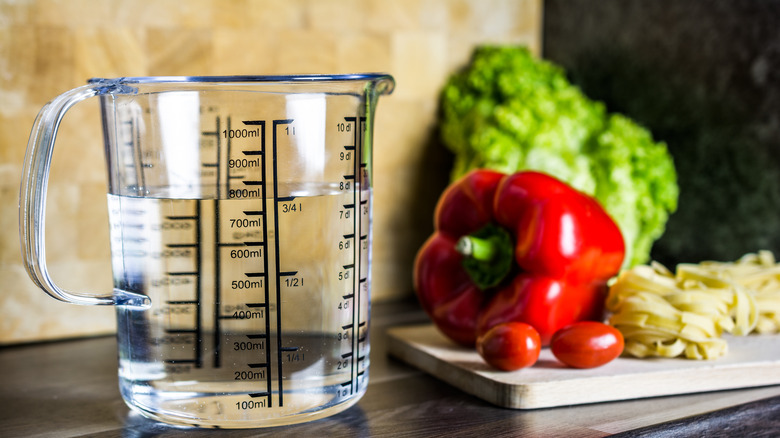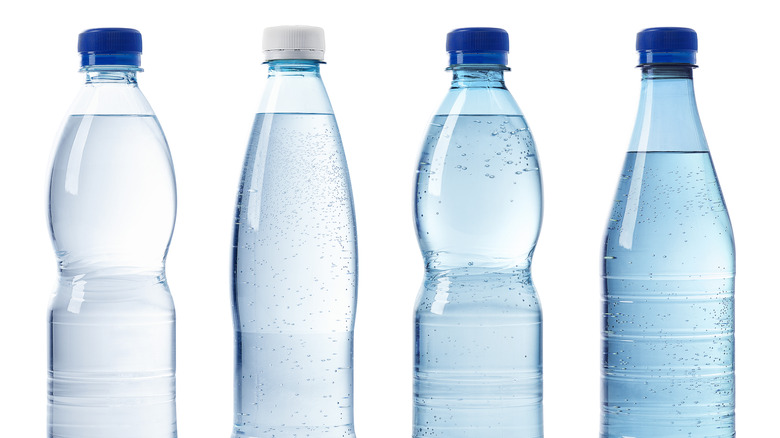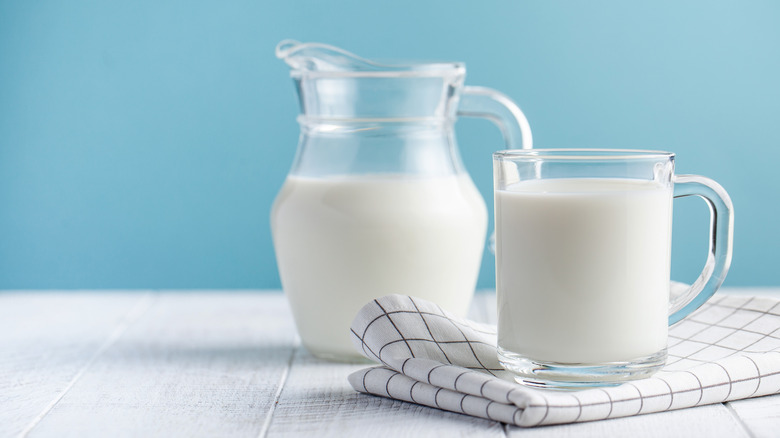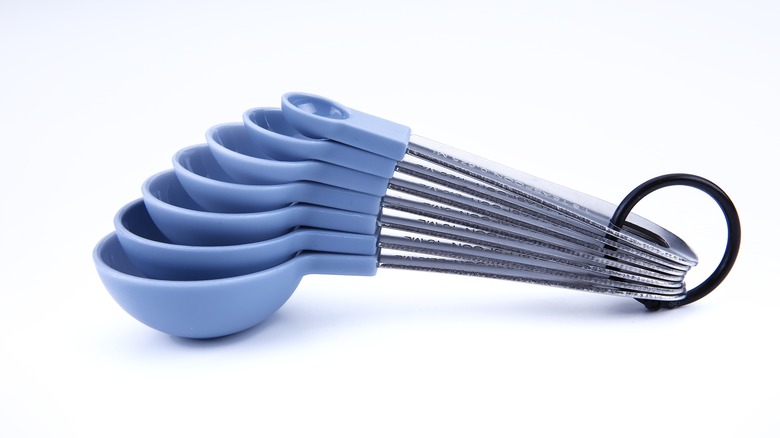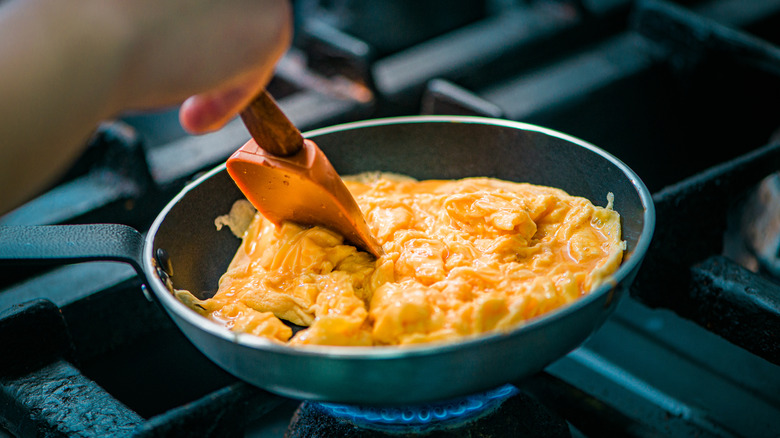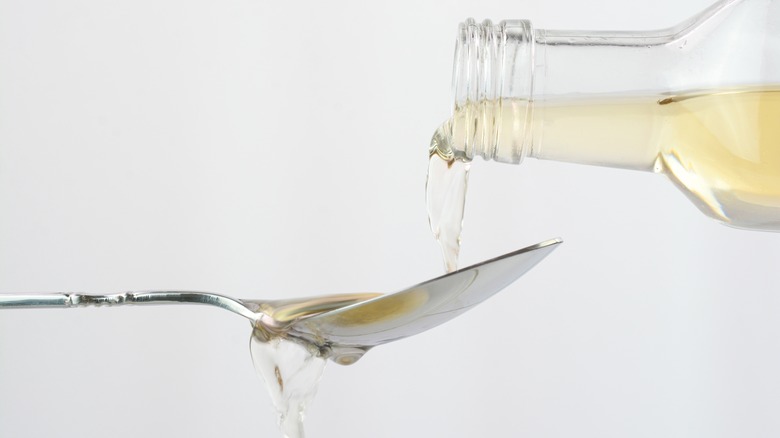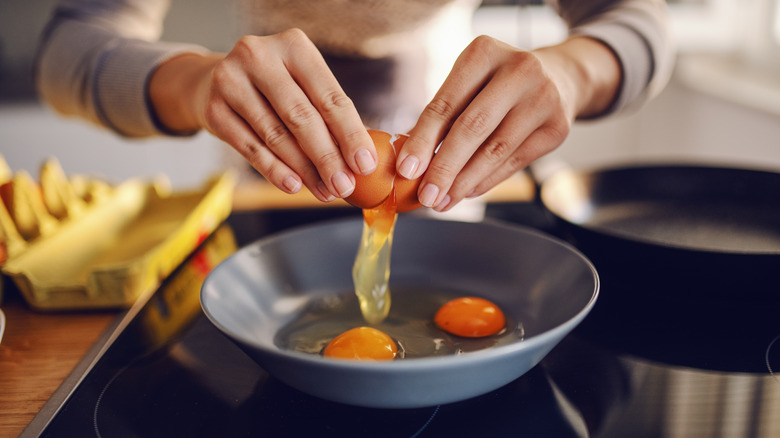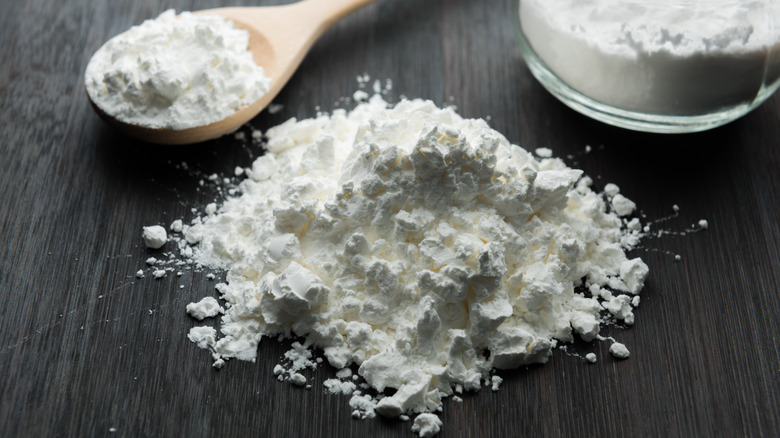The Water Vs Milk Egg Debate Explained
A quick internet search will convince you that there are more scrambled egg hacks out there than there are cooks. Any chef worth their salt has a proprietary scrambled egg recipe that employs creative techniques and ingredients that they claim will produce clouds of eggy goodness fit for a five-star brunch. From Ina Garten's truffle butter and chives to Trisha Yearwood's addition of cream cheese, celebrities, chefs, and celebrity chefs have provided enough fresh takes on the classic dish to keep you busy cooking eggs for every meal for the rest of your life.
But while there are plenty of cooking methods and ingredients that can take your scrambled eggs to the next level, two additions have become the subject of fierce debate: water and milk. At face value, you might think that the difference between a dash of water and a dash of milk is negligible, but there is a reason the topic has become so heated. The side you fall on depends on whether you prefer your scramble to be weightless and fluffy or rich and custardy.
If you haven't staked your claim yet or have never tried adding one of these liquids to your weekend scramble, it's time to brush up on the science behind it all. Here's why the water vs. milk debate really matters.
Why add liquid to scrambled eggs in the first place?
Maybe you've seen it in recipes or done it yourself without giving much thought about why, but putting liquid in your scrambled eggs has a scientific basis. Egg whites are composed partly of coiled strands of amino acids (the building blocks of protein) that uncoil and bind together when heated. This bonding process between amino acid strands can make scrambled eggs tough and rubbery if you cook them too long or at too high of a temperature.
Adding liquid such as milk or water prevents the eggs from getting rubbery as the liquid gets in between the amino acids and prevents them from bonding as quickly as they do when left to their own devices. As the liquid heats, it turns to steam and expands between the strands of amino acids, making the eggs fluffy rather than rubbery. Any liquid will create steam when heated, but there are differences of opinion about whether milk or water is the better option for other reasons.
The argument in favor of milk
Instinctively, you might be in favor of adding milk to your scrambled eggs rather than water. It has that rich, creamy dairy flavor that makes a milkshake more appetizing than, say, a glass of water. It also leads to a buttery texture in your scramble. Adding milk softens that eggy flavor that some people find unappetizing, leaving you with a delicious, lightly-flavored result. The fat in milk can likewise add a creamy flavor and thicken the consistency, while the water content in dairy will turn to steam and pushes apart the amino acid strands before they can bond too tightly.
Milk should be your liquid of choice if you like creamy, decadent scrambled eggs with a subtle flavor and light color. It's the perfect option if you want to add other ingredients, too, such as onions, peppers, and cheese, because it tempers the egg flavor, making them the perfect carrier for other flavors to shine through. On the flip side, however, the fat content of milk can make your scramble a little denser than you might like. Of course, some people also prefer their eggs to taste eggy.
The argument in favor of water
Although milk adds a creamy texture to your eggs, water beats dairy hands-down when it comes to making fluffy eggs. Instead of thickening the mixture like milk does, water quickly turns to steam without the fat or protein content of milk to slow the process down. Water quickly expands between the strands of amino acids and leading to a light, airy texture that can be cloud-like in appearance. The steam also helps the eggs cook evenly. Instead of the bottom of the pan being the only heat source, the hot steam rises through the layers of egg and cooks them at the same rate.
Water also has the benefit (or drawback, depending on your preferences) of leaving the eggy flavor undiluted. Unlike milk, which leaves behind its delicious fat, the water that you add to your scramble steams and evaporates, leaving nothing behind but tender, eggy deliciousness.
If you're looking for the purest form of scrambled eggs, water is your best bet. It yields a fluffy, brightly-colored final product that must be tried to be believed. If you still like a touch of dairy in your eggs, you can always add a little extra butter to the pan before tossing in the eggs or sprinkle cheese on top after the eggs have cooked.
What are the health considerations?
When deciding whether to use water or milk in your scrambled eggs, there are several nutritional factors to consider. If you're watching your calorie or fat intake, water is a zero-calorie, fat-free option that will still give your eggs a fluffy texture and delicious flavor. Another benefit of using water is that, since it steams your eggs, you won't need to add as much oil or butter to your pan as you would when pan frying them without liquid. For a calorie-conscious diet, water is the way to go.
Yet, milk has many health benefits as well. One cup of whole milk is packed with nutrients, including calcium, vitamin B12, potassium, and nearly a quarter of an adult's recommended daily intake of vitamin D. It also yields approximately eight grams of protein. While you won't be adding a whole cup of milk to your scrambled eggs, every little bit of nutrition helps, and dairy is packed with benefits, no matter your health goals.
Even Dolly Parton has weighed in on the debate
You know an online debate is worth your time when Dolly Parton leaps into the fray. The queen of country music voiced her opinion on the water vs. milk debate in 2022 when she revealed that she makes scrambled eggs every weekend for her husband of more than 50 years. Moreover, she never fails to add a dash of water.
"Somebody told me this once and it works," Parton told Insider. "When you crack your eggs in the bowl, say if you're going to scramble them, use ice water. Put a few drops of ice water as you're cooking them and that makes them fluffier — it really does!"
Not only is this advice in keeping with that of many professional cooks, but Parton's additional instruction to make sure the water is ice cold can be key. This ensures that the liquid does not evaporate too quickly and can significantly cool down your mixture. This tip is particularly helpful if you're a person who tends to overheat your pan when cooking.
If you opt for water, should you use still or sparkling?
It may seem like splitting hairs, but there really is a difference between still and sparkling water when it comes to scrambling eggs. While normal tap water will work wonders simply by turning into steam and pushing apart the uncoiling amino acid strands, you can take it further. Carbonated water, the drink that probably brings to mind leisurely summer days and slices of lemon rather than an eggy brunch, packs an extra punch thanks to all of its tiny bubbles.
When you add a splash of sparkling water to your scrambled eggs, you're adding even more to the effect of the tap water. As the bubbles begin to heat, the air inside them expands, forcing even more space between the amino acids before the water steams and evaporates, making them even fluffier than what you get with still water. It probably isn't worth the extra time required to rush to the store to buy a bottle of San Pellegrino for your morning scramble, but the next time you have some leftover (unflavored) seltzer, it's worth a try.
If you want to use dairy, should you opt for milk, half-and-half, or cream?
Just as sparkling water yields a different result from still water, the type of dairy you use will greatly affect your final product. Celebrity chef Jacques Pépin swears by cream, choosing to add a tablespoon after cooking the eggs, using the high-fat dairy to cool the scramble and prevent it from overcooking. "Top Chef" contestant Nyesha Arrington is also a fan of using cream, saying that adding just a splash to the mixture leads to the fluffiest scrambled eggs.
But while cream is the most effective way to make your eggs rich and velvety, it can also overpower the dish by coating your mouth with a residue of fat. You might associate this sensation with eating whipped cream or a decadent custard rather than scrambled eggs.
Whole milk provides the richness of dairy without dominating the flavor of the eggs or leaving a fatty residue in your mouth. Its higher water content allows for more steam, which creates the fluffy texture many cooks are looking for. Meanwhile, half-and-half, at around 10.5% to 18% milk fat compared to 36% in cream and 3.25% in whole milk, strikes a good balance if you're not quite up for the richness of cream but prefer more creaminess than what milk can offer.
Ratios are key, regardless of which liquid you choose
When you're adding liquid to your scrambled eggs, regardless of whether it's water or milk, moderation is key. The amount you should incorporate is so small that you might wonder if it's enough to make a difference, but rest assured that just one tiny splash of water will work overtime to fluff up those proteins.
If you add too much liquid, your eggs will be fully cooked before the moisture has had a chance to steam off, leaving you with lumps of rubbery, overcooked eggs in a pool of un-evaporated water. If you add too little liquid, you'll have the same dense eggs as you get when you scramble them with nothing but butter.
Luckily, the ratios are simple. One to two teaspoons of your liquid of choice per egg is the sweet spot, though you can get away with closer to a tablespoon if you're using milk or cream and want all the richness you can get. While you're at it, make sure you've whisked the ingredients thoroughly to break up the egg. This incorporates more air into your eggs, adding to their overall fluffiness while also ensuring that you don't end up with separate pockets of egg white and yolk.
How to add water or milk to your eggs
Scrambled eggs are a deceptively tricky dish to get right, but knowing the chemistry that goes into cooking them will yield predictable and delicious results. Once you've added the proper amount of water or dairy and whisked the ingredients, cook the mixture on low heat, keeping in mind that the presence of the liquid will make the process take longer than it does when you're just using eggs. High heat will cause the liquid to burn off too quickly and allow the amino acids to build tight bonds that make the eggs tough. Cooking them at a lower temperature gives the steam time to work its magic and prevents the bottom of the eggs from cooking too quickly and becoming rubbery.
Continually stirring your eggs while they're cooking can also lead to undesirable results, as it disrupts the steaming process and can deflate the eggs of the air that you've so carefully incorporated into them through whisking and slowly steaming them. Instead, opt for a gentle scoop at approximately 20-second intervals so that the eggs are cooked evenly but not overworked or deflated.
And last but not least, always remove the pan from the heat just before the eggs are finished cooking. They will continue to cook through the residual heat in the pan and will be perfectly done by the time you transfer them to a plate.
What about other liquids?
The debate about which liquid to put in scrambled eggs is frequently framed as a binary struggle between water and milk, but there are many alternatives to consider. These other options often focus on flavor more than texture, but sometimes, that's exactly what you're looking for. If your diet does not include dairy but you want a little more creaminess than water offers, you can try plant-based milk alternatives such as oat milk or soy milk, both of which will add to the richness of your scramble with minimal flavor.
If flavor is what you're after, try a dash of soy sauce or sriracha. The water content of soy sauce will have a similar steaming effect as plain water or milk, and lend the wonderful taste of umami to your eggs. Adding an acidic liquid to your eggs is another hack that some cooks favor. Tossing in a dash of lemon juice or high-quality vinegar tenderizes the eggs, makes them softer, and gives an unexpected kick of flavor that might just hit the spot.
Some people also claim that you should add orange juice to the process, not as a drink to wash it down while eating, but as a key ingredient of your scramble. Not only will the brightly-colored juice enhance the natural color of the eggs, but it will give a subtle citrus flavor that can cut through the salt and fat without being as sharp as lemon or lime juice.
Do you even need liquid?
After discovering all the benefits of adding liquid to your eggs, you'll never want to look back. But some chefs skip this step entirely, insisting that, providedyour eggs are of a high quality, you don't need anything other than a bit of butter to grease the pan. Chef Jamie Oliver dismisses the notion of adding liquid, saying that "if you cook it right," your scramble doesn't need milk, cream, or anything other than the eggs and a dab of butter.
Martha Stewart agrees. "People add water, they add milk, they add cream to their scrambled eggs," she said, but insists that "if you have really good eggs, you don't need anything in the eggs at all." Both Oliver and Stewart have decades of expertise to back up their claims, but the variety of famous scrambled egg recipes is evidence that there is more than one "right" way to make the dish. If you want the fluffiest scrambled eggs possible, the science conclusively proves that adding liquid is the way to go. This does not mean, however, that it is the only method that will yield tasty results, and keeping your recipe as simple as possible will save time and possibly a trip to the grocery store.
Some chefs swear by a non-liquid ingredient for a creamy, fluffy texture
While some chefs swear by cream or just plain eggs, others have a more unusual hack that even makes Gordon Ramsay's crème fraiche and sea urchin recipe look pedestrian. According to food writer and chef J. Kenji López-Alt, cornstarch is your golden ticket to creamy, mouthwatering eggs. The recipe, which he picked up from blogger Mandy Lee, begins with creating a slurry out of starch and water before adding the eggs and cold cubes of butter. The starch acts as a barrier between the proteins, preventing them from bonding and toughening the eggs. It also absorbs any excess moisture, turning to a creamy sauce rather than evaporating and leaving dry eggs.
This method works in a completely different way to adding liquid, since the goal is to trap the liquid in the starch rather than letting it fluff up the eggs as it steams. Whichever method you prefer is down to personal taste, but it's difficult to beat water when it comes to convenience.
The liquid you choose really does matter
The debate about whether to use milk or water may seem arbitrary when considering all the other ingredients you can add to scrambled eggs. But while there is no right or wrong answer, it's clear that the liquid you choose will make a meaningful difference to your eggs. If you prefer custardy, velvety eggs with a subtle flavor and a thick texture, milk is your MVP. If you prefer a fluffy, light-as-air scramble that maintains an unmistakably eggy flavor and a rich yellow color, water is your winning ingredient.
Once you know which kind of eggs you prefer, you can play around with the variations. If you like adding water, try using unflavored seltzer to give an extra dimension of fluff. If you like adding dairy, try cream or half-and-half. Regardless of whether you use milk or water, your scrambled eggs will receive a major upgrade with just one teaspoon of the liquid — no cheese, onions, mushrooms, or sea urchins needed.
